







The Triumph Motor Company was a British car and motor manufacturing company in the 19th and 20th centuries. The marque had its origins in 1885 when Siegfried Bettmann of Nuremberg formed S. Bettmann & Co. and started importing bicycles from Europe and selling them under his own trade name in London. The trade name became "Triumph" the following year, and in 1887 Bettmann was joined by a partner, Moritz Schulte, also from Germany. In 1889, the businessmen started producing their own bicycles in Coventry, England.
Triumph manufactured its first car in 1923. The company was acquired by Leyland Motors in 1960, ultimately becoming part of the giant conglomerate British Leyland (BL) in 1968, where the Triumph brand was absorbed into BL's Specialist Division alongside former Leyland stablemates Rover and Jaguar. Triumph-badged vehicles were produced by BL until 1984 when the Triumph marque was retired, where it remained dormant under the auspices of BL's successor company Rover Group. The rights to the Triumph marque are currently owned by BMW, who purchased the Rover Group in 1994.

The company was renamed the Triumph Cycle Co. Ltd. in 1897. In 1902 they began producing Triumph motorcycles at their works in Coventry on Much Park Street. At first, they used engines purchased from another company, but the business prospered and they soon started making their own engines. In 1907 they purchased the premises of a spinning mill on Priory Street to develop a new factory. Major orders for the 550 cc Model H were placed by the British Army during the First World War; by 1918 Triumph had become Britain's largest manufacturer of motorcycles.
triumph motor company

In 1930 the company's name was changed to Triumph Motor Company. Holbrook realised he could not compete with the larger car companies for the mass market, so he decided to produce expensive cars, and introduced the models Southern Cross and Gloria. At first they used engines made by Triumph but designed by Coventry Climax, but in 1937 Triumph started to produce engines to their own designs by Donald Healey, who had become the company's experimental manager in 1934. In July 1939 the Triumph Motor Company went into receivership and the factory, equipment and goodwill were offered for sale.
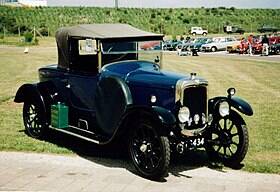
1923-1926
The Triumph 10/20 was a car manufactured from 1923 to 1926 by the Triumph Motor Company. It was the first Triumph automobile and was named the 10/20 for the Royal Automobile Club's taxation class of 10 horsepower rating and its actual output of 20 brake horsepower. The design was principally by Arthur Alderson assisted by Alan Lea and Arthur Sykes who were employed by Lea-Francis, to whom Triumph paid a royalty on every car made. It was powered by a 1,393 cc 4-cylinder side-valve engine. The engine produced 23.5 brake horsepower at 3000 rpm, giving the car a top speed of 84 km/h.

1934-1938
The range of Gloria sporting saloons, coupés, tourers, 2-seater sports cars, drophead coupés and golfer’s coupés were produced. All these Glorias, apart from the final two models (1.5-Litre Saloon and Fourteen (1767 cc) Six-Light Saloon of 1937-1938) were powered by 1087 or 1232 cc four-cylinder or 1467 or 1991 cc six-cylinder Coventry Climax overhead inlet and side exhaust valve designed engines (modified and built under licence by Triumph).
From August 1934 to 1936 the Gloria range included ‘Gloria Vitesse’ models (not to be confused with later Vitesses) which were up-rated, with twin carburettor engine and equipment, versions of the equivalent Gloria and slightly different bodywork in the case of some saloons.
standard triumph
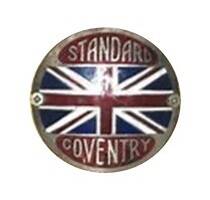
In November 1944 what was left of the Triumph Motor Company and the Triumph trade name were bought by the Standard Motor Company and a subsidiary "Triumph Motor Company (1945) Limited" was formed with production transferred to Standard's factory at Canley, on the outskirts of Coventry. In the early 1950s it was decided to use the Triumph name for sporting cars and the Standard name for saloons and in 1953 the Triumph TR2 was initiated, the first of the TR series of sports cars that were produced until 1981. The last Standard car to be made in the UK was replaced in 1963 by the Triumph 2000.

1946-1949
The 1800 Roadster, model number 18TR, was designed in the closing days of World War II. The engine was a version of Standard's 1.5-litre, four-cylinder side-valve design that had been converted to overhead valves by Harry Weslake and built by Standard exclusively for SS-Jaguar before World War II.
Early post-war steel shortages meant that most of the body was built from aluminium over an ash frame, using rubber press tools that had been used making panels for the largely wooden bodied Mosquito bomber that had been built by Standard during the war.

1953-1955
In the early 1950s it was decided to use the Triumph name for sporting cars and the Standard name for saloons and in 1953 the Triumph TR2 was initiated, the first of the TR series of sports cars that were produced until 1981. Curiously, the TR2 had a Standard badge on its front and the Triumph globe on its hubcaps.
The car had a 1991 cc four-cylinder Standard wet liner inline-four engine from the Vanguard, fitted with twin H4 type SU Carburettors and tuned to increase its output to 90 bhp. A total of 8,636 TR2s were produced. It was replaced by the TR3 in 1955.
leyland

Standard-Triumph was bought by Leyland Motors Ltd. in December 1960. In 1968 Leyland merged with British Motor Holdings (created out of the merger of the British Motor Corporation and Jaguar two years earlier) which resulted in the formation of British Leyland Motor Corporation. During the 1960s and '70s Triumph sold a succession of Michelotti-styled saloons and sports cars, including the advanced Dolomite Sprint, which, in 1973, already had a 16-valve four-cylinder engine. It is alleged that many Triumphs of this era were unreliable. For most of its time under Leyland or BL ownership the Triumph marque belonged in the Specialist Division of the company, which went by the names of Rover Triumph and later Jaguar Rover Triumph.
the end

The last Triumph model was the Acclaim, introduced in 1981 and essentially a rebadged Honda Ballade built under licence from the Japanese carmaker Honda, at the former Morris Motors works in Cowley, Oxford. The Triumph name disappeared over the summer of 1984, when the Acclaim was replaced by the Rover 200, a rebadged version of Honda's next generation Civic/Ballade model. This was the first phase of a rebranding of the Rover Group which would also see the Austin and Morris brands disappear by the end of the 1980s and the Rover brand dominate most of the company's products.
The BL car division had by then been named the Austin Rover Group, which also retired the Morris marque in 1984 as well as the Triumph brand.
tr-x
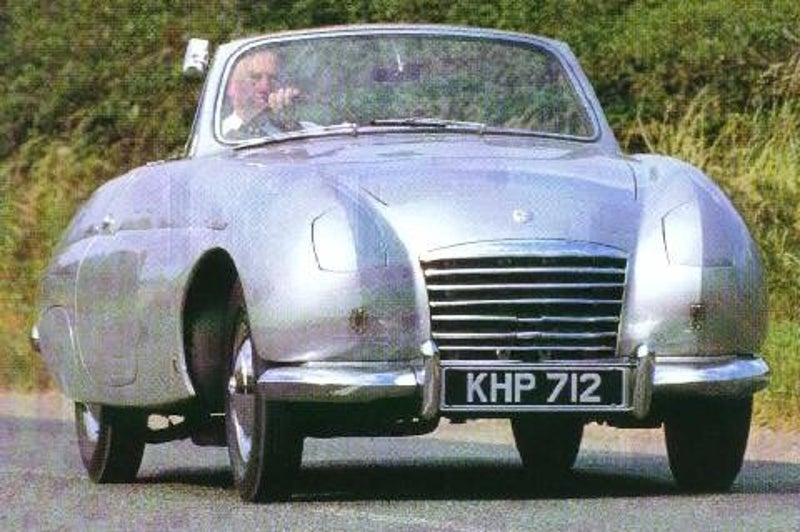
1950



The Triumph TR-X, also known as the "Silver Bullet", was the first Triumph car to use the TR designation. It was first shown to the public at the Paris Auto Show in late 1950. Envisioned as a personal luxury car, it had envelope styling with aluminium body panels, spats over the rear wheels, electro-hydraulically operated seats, windows, and top, onboard hydraulic jacks, and electrically-operated hidden headlights. The TR-X used the Standard Vanguard's chassis and engine, the Triumph Renown's suspension, electrically operated overdrive, and a 94 inch wheelbase.
The TR-X was discontinued after only two had been built. Standard-Triumph could not develop and manufacture a car that complicated and still sell it at a profit. Sir John Black, chairman of Standard-Triumph, was determined to have a sports car to compete with Morgan, which he had earlier tried to buy. Black ordered the design of a sports car using existing chassis, suspension, and engine, and inexpensive bodywork. Other design objectives were a price of approximately £500 and a top speed of at least 90 mph.
italia 2000 coupé

1952-1962



The Triumph Italia 2000 Coupé was built between 1959 and 1962, during which time 330 cars were produced. Designed by Giovanni Michelotti, the TR3 chassis and mechanical components were supplied by the Triumph Motor Company in the United Kingdom, and built by Alfredo Vignale in Turin, Italy.
By most accounts, only 330 (2 prototypes and 328 numbered production cars) of these hand-crafted bodies on TR3 chassis were ever built – known as the Triumph "Italia 2000 Coupé".
Ruffino envisioned building 1,000 cars, between 1960 and 1962, with worldwide distribution including the American marketplace. He had a verbal agreement to have every Triumph dealer (720) purchase an Italia. The Italia never became an official model of Standard-Triumph.
Faced with ensuing financial and labor problems, Standard-Triumph was taken over by Leyland Motors in 1961. The new management did not follow through with the verbal contract that Ruffino had made with Triumph. Perhaps fearing increased competition, Triumph concentrated their efforts on the new TR4 to be released in 1962. The TR4, also designed by Michelotti, clearly borrowed many elements from the Italia: the distinctive bonnet bulge, kick-up door with wind-up windows, and roomier modern body design.
With Triumph's decision not to distribute the Italia, Ruffino S.p.A. re-badged the car as the Italia 2000 and continued production. Over a three-year production period (mid-1959 to mid-1962) Vignale produced approximately 330 cars. Six cars were produced in right-hand drive. The first show car, Italia #1, was converted to right-hand drive after being sold by Standard-Triumph. After a six-month halt in production, the last run of 29 cars was based on the TR3B chassis. These all used the TSF chassis specification and, as such, retained the 1991cc engine and non-synchro first gear transmission of the TR3.
tr series

1952 tr1
The Triumph 20TS was a prototype sports car shown by Standard-Triumph in October 1952 at the London Motor Show. Extensive development of the 20TS led to the introduction of the Triumph TR2 in March 1953 at the Geneva Motor Show, after which the 20TS was unofficially referred to as the Triumph TR1. Only one example of this car was ever made by Triumph.
The 20TS was built using existing components: its engine came from the Standard Vanguard, its suspension from the Triumph Mayflower, and its chassis from the Standard 8 hp, itself based on the pre-war Standard Flying Nine. The body was designed to be built economically, with no panels requiring double-action presswork

1953-1955 tr2
The Triumph TR2 is a sports car produced by the Standard Motor Company in the United Kingdom between 1953 and 1955. It was only available in roadster form.
The car had a 1991 cc four-cylinder Standard wet liner inline-four engine from the Vanguard, fitted with twin H4 type SU Carburettors and tuned to increase its output to 90 bhp. The body was mounted on a substantial separate chassis with coil-sprung independent suspension at the front and a leaf spring live axle at the rear.

1955-1962 tr3
The TR3 is an evolution of the company's earlier TR2 model, with greater power and improved braking. Updated variants, popularly but unofficially known as the "TR3A" and "TR3B", entered production in 1957 and 1962 respectively. The TR3 was succeeded by the Michelotti-styled, mechanically similar Triumph TR4.
The Triumph was campaigned in races, hill climbs, and rallies across Europe and North America, with several outright, team, and class victories to its credit.

1961-1965 tr4
The Triumph TR4 is a sports car produced from 1961 to 1965. As the successor to the TR3A, the car was based on the chassis and drivetrain of the previous TR sports cars, but with a modern body designed by Michelotti.
In spite of its modern styling, a total of only 40,253 cars were built during its 5-year production run. In comparison, the TR2 sold 8,635 units in its 3-year run from 1953–1955; 74,800 TR3s in an 8-year run from 1955 to 1962; 94,500 TR6s in an 9-year run from 1968–1976,; and 111,500 TR7s over a 7-year run from 1975–1981.

1967-1968 tr5
Visually similar to the TR4 (also styled by Michelotti), the TR5 roadster sported Triumph's much more powerful 2.5-litre straight-6, fitted with Lucas mechanical fuel-injection and producing 150 bhp. Price pressures and tighter emissions standards in the U.S. resulted in a much less powerful carburetted version, the TR250, being sold on the North American market.
At the time, fuel injection was uncommon in road cars. Triumph claimed in their sales brochure that it was the "First British production sports car with petrol injection".

1968-1976 tr6
All TR6s were powered by Triumph's 2.5-litre straight-6, with the same Lucas mechanical fuel-injection as the TR5 for the United Kingdom and global markets, and carburetted for the United States, as had been the US-only TR250. The TR6PI (petrol-injection) system helped the home-market TR6 produce 150 bhp at model introduction. The TR6 was the best-seller of the TR range when production ended, a record subsequently surpassed by the TR7. Of the 91,850 TR6s produced, 83,480 were exported; only 8,370 were sold in the UK.

1975-1981 tr7
The car, characterised by its "wedge" shape and by a swage line sweeping down from the rear wing to just behind the front wheel, was commonly advertised as: "the shape of things to come". The design was penned by Harris Mann who also designed the wedge-shaped Princess. Power is provided by a 1,998 cc eight-valve four-cylinder engine that shares the same basic design as the Triumph Dolomite 1850 engine, albeit increased to 2 litres and fitted with larger carburettors, mounted in-line at the front of the car. Power is 105 bhp.

1978-1981 tr8
The Triumph TR8 is an eight-cylinder version of the "wedge-shaped" Triumph TR7 sports car, designed by Harris Mann, and manufactured by British Leyland (BL), through its Jaguar/Rover/Triumph (JRT) division. Because of its outstanding performance, the TR8 was often dubbed the "English Corvette". The majority of TR8s were sold in the United States and Canada. The TR8 did not use Triumph's own single overhead cam V8 as found in the Stag due to its weight and service record but instead shared its Rover V8 engine with the Rover SD1.

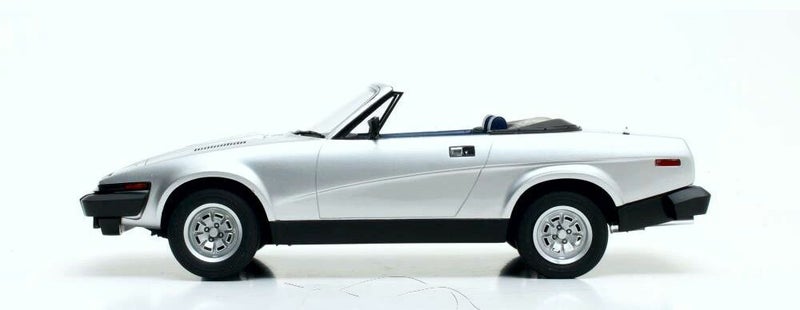
herald

948 1959-1960

1200 1961-1962

12/50 963-1967

13/60 1968-1971
The Triumph Herald is a small two-door car introduced by Standard-Triumph of Coventry in 1959 and made through to 1971. The body design was by the Italian stylist Giovanni Michelotti, and the car was offered in saloon, convertible, coupé, estate and van models, with the latter marketed as the Triumph Courier.
Total Herald sales numbered well over half a million. The Triumph Vitesse, Spitfire and GT6 models are all based on modified Herald chassis and running gear with bolt-together bodies.
Standard-Triumph experienced financial difficulties at the beginning of the 1960s and was taken over by Leyland Motors in 1961. This released new resources to develop the Herald and the car was re-launched in April 1961 with an 1147 cc engine as the Herald 1200.
An upmarket version, the Herald 12/50, was offered from 1963 to 1967. It featured a tuned engine with a claimed output of 51 bhp (38 kW) in place of the previous 39.
In October 1967 the range was updated with the introduction at the London Motor Show of the Herald 13/60. The 13/60 was offered in saloon, convertible and estate-bodied versions. In this form (though the 1200 saloon was sold alongside it until the end of 1970) the Herald Saloon lasted until December 1970 and the Convertible and Estate until May 1971.
spitfire

1962-1964 mkI

1965-1967 mkII
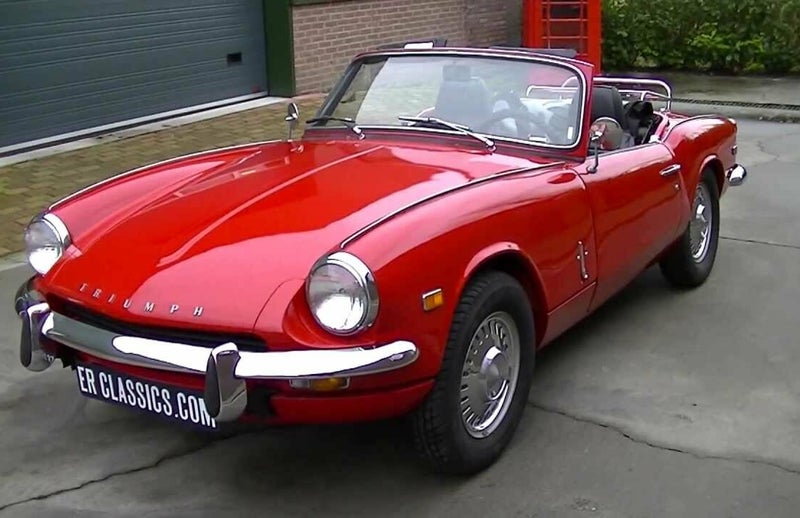
1967-1970 mkIII

1970-1974 mkIV

1974-1980 1500
The Triumph Spitfire is a British front-engined, rear-wheel drive, two-passenger convertible sports car introduced in 1962 and manufactured between 1962-1980. Styled for Standard-Triumph in 1957 by Italian designer Giovanni Michelotti, the Spitifire was manufactured for the duration of its production at the Standard-Triumph Canley works — and evolved over a series of five production iterations, with a approximately 315,000 manufactured over 18 years. The Spitfire nameplate refers to the World War II fighter plane of the same name. Assembled at Canley in August 1980 shortly before the factory closed, the last Spitfire was an Inca Yellow UK-model including the factory hardtop and overdrive options. Never sold to the public, it remains on display at the British Motor Museum.
mark I: The production design changed little from the prototype. Bodywork was bolted to the much-modified Herald chassis and the engine was an 1,147 cc four-cylinder with a pushrod OHV cylinder head and two valves per cylinder, using twin SU carburettors.
mark II: In March 1965 the Spitfire Mark II launched with a retuned engine increasing power to 67 bhp. Top speed was claimed to be 154 km/h and its 0–100 km/h time of 14.8 seconds was considered "lively".
mark III: Introduced in March 1967, it was the first major facelift to the Spitfire. The front bumper was raised in response to new crash regulations. The 1,147 cc engine was replaced with a bored-out 1,296 cc unit and now the engine put out a claimed 75 bhp. On 8 February 1968, Standard-Triumph general manager George Turnbull drove the 100,000th Triumph Spitfire off the Canley production line. More than 75 per cent of this number had been exported outside the UK.
mark IV: The Mark IV featured a redesigned rear design similar to the Triumph Stag and Triumph 2000 models, both also designed by Michelotti. The front end was revised with a new bonnet pressing eliminating the weld lines on top of the wings/fenders, door handles were recessed, the convertible top received squared-off corners. The Mk. IV engine displaced 1,296 cc and was now rated at 63 horsepower.
1500: In 1973 in the United States and Canada, and 1975 in the rest of the world, the 1500 engine was used on the MK IV body to make the Spitfire 1500. The 1500 Spitfire now produced 71 hp at 5500 rpm, and produced 111 N⋅m of torque at 3000 rpm. Top speed was now at the 160 km/h mark, and 0 to 100 km/h was reached in 13.2 seconds.
vitesse

1962-1971



The Triumph Vitesse is a compact six-cylinder car built by Standard-Triumph from May 1962 to July 1971. The car was styled by Giovanni Michelotti, and was available in saloon and convertible variants.
The Vitesse name was first used by Austin on their 1914–16 Austin 20 (hp) and 30 (hp) Vitesse models, this was followed in 1922 by G. N.(Godfrey & Nash) on their GN Vitesse Cyclecar, and then by Triumph on a car made between 1935 and 1938.
The Vitesse 6 sold extremely well for Triumph, and was by some way the most popular Vitesse sold during the model's lifetime. The car was well liked for its performance and reasonable fuel economy, and the well-appointed interior. The exceptionally small turning circle was also liked by users. With its ability to perform as well as many sports cars, but with room for a family, the Vitesse had few rivals for the price. The convertible in particular was virtually unique in the marketplace; another genuine four-seater sporting convertible would not reappear from a British manufacturer until the Triumph Stag several years later.
After the last Triumph Vitesse was made in July 1971, the name remained unused until October 1982, when Rover used it on their SD1 until 1986, from 1984 to 1990 on the SD3 216, and one final time on their Rover 800, 820 and 827 models from October 1988 to 1991, at which time that car was rebodied as the R17 version, which was produced until 1998 as the Rover Vitesse Sport. The Vitesse sold well until its withdrawal in July 1971, seven months before the new Triumph Dolomite saloon entered the performance luxury sector for Triumph. Although the Vitesse was an older model, it proved to be more reliable than its replacement, due to its simpler and more proven engine design.
2000

mkI 1963-1969


mkII 1969-1977

The Triumph 2000 is a mid-sized, rear wheel drive automobile which was produced between 1963 and 1977. It was introduced on 15 October 1963. Larger-engined models, known as the Triumph 2.5 PI and Triumph 2500 were also produced from 1968. The 2000 used the six-cylinder engine first seen in the Standard Vanguard at the end of 1960.
Triumph's 2000 competed with the contemporary Rover P6 2000, which initially was offered only with a four-cylinder engine. The Rover was also released in October 1963, just one week before the Triumph.
Styled by Michelotti, the Triumph had a slightly longer wheelbase and was slightly wider, with a correspondingly more spacious interior, than its rival. Together, the cars defined a new market sector in the UK, promising levels of comfort and luxury hitherto associated with larger Rover and Jaguar models, but with usefully lower running costs and purchase prices, all in a modern package.
The Mk 2, the last big Triumph car, ceased production in 1977, supplanted by British Leyland's corporate executive car, the Rover SD1.
gt6

1966-1973
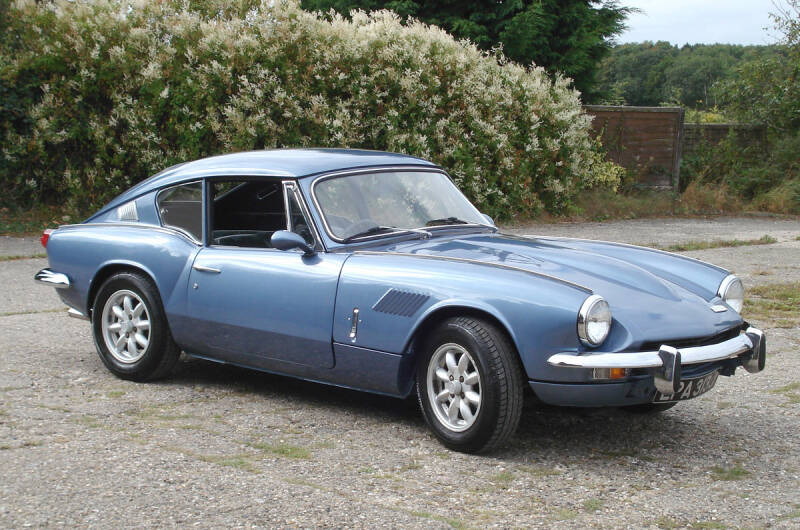

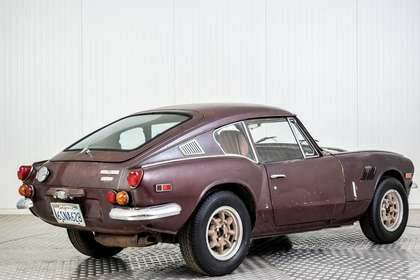
The Triumph GT6 is a 6-cylinder sports coupé built by Standard-Triumph, based on their popular Triumph Spitfire convertible. Production ran from 1966 to 1973.
In early 1963 Giovanni Michelotti was commissioned by Standard-Triumph to design a GT version of their recently introduced Spitfire 4 (also designed by Michelotti). An unmodified Spitfire 4 was delivered to Michelotti's design studios in Italy and late in 1963 the prototype Spitfire GT4 was returned to England for evaluation. The styling of the vehicle was a success but the extra weight of the GT bodyshell resulted in extremely poor performance from the Spitfire's 1,147 cc Standard SC engine, and plans for producing the Spitfire GT4 were shelved. After the succes in racing and the le mans races the Spitfire's 4-cylinder engine was replaced with the more powerful 2.0 L (1,996 cc) Triumph inline 6 originally derived from the SC and then in use in the Triumph Vitesse (which shared a similar chassis with the Spitfire and Triumph Herald). Contemporary Triumph marketing advertised the GT6 as being developed from the "race winning Le Mans Spitfires" to capitalise on their aesthetic similarities, whereas the Le Mans Spitfires and the GT6 were actually two entirely separate development programmes.
tr5 ginerva

1968


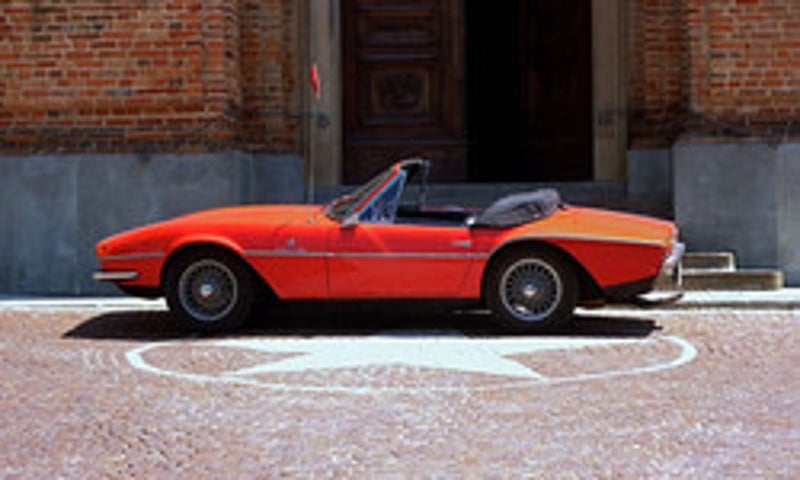
Just before the Geneva Motor Show in March 1968, Michelotti was about to organise the presentation of the new Triumph Stag on his stand. But the Standard Triumph directors had a sudden change of mind and decided to put the Stag on the official Triumph stand. This left Michelotti with a vacant space. He had to react quickly, and decided to design a prototype, which he presented as the evolution of the TR5 – the future TR6! Employees, friends and family members burned the midnight oil for 15 days and 15 nights to prepare this prototype called the TR5 Ginevra (Geneva in Italian). Michelotti obtained a TR5 chassis from the factory to build his prototype numbered X760 (prototype) as well as a 2-litre straight 6 engine (not the 2.5 version) fitted with Lucas injection. It had a standard 4-speed plus overdrive gearbox.
After the show the Standard Triumph management entrusted the Karmann bodywork company with the task of designing the future TR6. The TR5 Ginevra remains a one-off much to the delight of its present-day owner.
This was the personal daily car of Giovanni Michelotti for some years after construction.
toledo




1970-1976
The Triumph Toledo is a compact car which was produced by the Rover-Triumph division of British Leyland in the United Kingdom from 1970 to 1976.
The Toledo was introduced in August 1970 as a cheaper version of the Triumph 1300, which was at the same time replaced by the Triumph 1500. The Toledo, like the front-wheel drive 1500, came with a new split grille at the front, but instead of the 1500's twin round headlamps, it had single rectangular units set in a grey plastic grille. The rear end was like that of the 1300 except for the tail lights, which were of a simpler, flat-faced design.
The biggest change for the Toledo was a move to rear-wheel drive and live rear axle (still with coil springs), in the interest of simplicity and low production costs. The interior was also cheaper, with wood confined to a dashboard consisting of a simple plank with holes drilled for the quite basic instrumentation but the interior was a cut above most other small cars at a time when black plastic was commonplace.
Initially, the Toledo was only available as a two-door saloon with the 1296 cc engine Standard SC engine of 58 bhp. In 1971 a 4-door "special export" version was launched featuring a 1500 cc engine in single and twin carburettor "TC" form producing 61 and 64 bhp.
stag

1970-1977

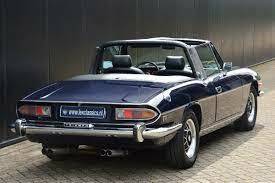

Envisioned as a luxury sports car, the Stag was designed to compete directly with the Mercedes-Benz SL class models. All Stags were four-seater convertible coupés, but for structural rigidity – and to meet proposed American rollover standards of the time – the Stag required a B-pillar "roll bar" hoop connected to the windscreen frame by a T-bar. A body color removable hard top with defrost wires on the rear window, full headliner and lever operated quarter windows was a popular factory option for the early Stags, and was later supplied as a standard fitment. The car started as a styling experiment cut and shaped from a 1963–64 pre-production 2000 saloon, also styled by Giovanni Michelotti.
Triumph gave new projects four letter development code names (e.g. Bomb for Spitfire) and interestingly, Stag was the only Triumph to take its development code name into production.
The car was launched one year late in 1970, to a warm welcome at the various international auto shows. The Stag rapidly acquired a reputation for mechanical unreliability, usually in the form of overheating. These problems arose from a variety of causes. The combination of manufacturing and maintenance flaws caused a large number of engine failures. Time magazine rated the Triumph Stag as one of the 50 worst cars ever made. British Leyland never materially reengineered the Triumph 3.0 litre OHC V8 to address these issues. Perhaps thanks to the Stag engine's reputation for unreliability, only 25,877 cars were produced between 1970 and 1977. Of this number, 6,780 were export models, of which 2,871 went to the United States.
The Stag was never directly replaced. British Leyland planned an equivalent model to follow the Stag in the form of a derivative of the Triumph TR7 sports car which was codenamed the Lynx.
dolomite




1972-1980
The Dolomite was the final addition to Triumph's small-car range (codenamed "Project Ajax"), which had started in 1965 with the Triumph 1300. Designed to be a replacement for the rear-wheel drive Triumph Herald, the 1300 was originally fitted with a 1,296 cc engine and front-wheel drive. The later model, introduced in September 1970 as the Triumph 1500, featured a remodelled front and rear, styled by Michelotti, and a larger 1,493 cc engine.
Triumph were however dissatisfied with the market performance of the 1300; although it had been moderately successful, the higher price and greater complexity meant sales never reached the levels of the simpler and cheaper Herald which preceded it. In an attempt to improve matters, the car was comprehensively re-engineered. Launched in September 1970, the Triumph Toledo was a cheaper and more basic variant of the 1300, but with conventional rear-wheel drive. This new model was assembled alongside the now larger-engined front-wheel drive version (the Triumph 1500) which was launched at the same time as the Toledo.
Although the Dolomite proved to be refined and rapid, competitors such as the BMW 2002 had a performance advantage which was costing Triumph dearly, both in terms of sales and prestige. To remedy this, Triumph unveiled the Dolomite Sprint in June 1973, although the launch had been delayed by a year; it had been due to go on sale in 1972.
Despite BL engineers being able to extract a reliable 150 bhp from test engines, the production line was unable to build the engines to the same level of quality, with production outputs being in the region of 125 bhp to 130 bhp . This led to the original model designation, the Dolomite 135, being replaced at short notice with the Sprint name.
acclaim

acclaim 1981-1984



The Triumph Acclaim is a front-wheel drive compact family saloon/sedan manufactured by British Leyland (BL) from 1981 to 1984, as a locally built version of the Honda Ballade. It was the final vehicle marketed under the Triumph marque, and the first product of the alliance between BL (later the Rover Group) and Honda which would last until the mid 1990s. The end of Dolomite and TR7 production meant that the Acclaim was the only car to wear the Triumph badge after 1981.
The Acclaim was the first Japanese-designed car manufactured within the European Economic Community (now the European Union), to bypass Japan's voluntary limit of 11 per cent market of the total number of European sales. It was a major turnaround point for BL itself, achieving both reliability and high build quality from the outset.
The Acclaim was Britain's seventh best selling car in 1982 and the eighth best selling car in 1983.
The demise of the Acclaim came in June 1984 when the Rover 200 was launched, based on the next incarnation of the Honda Ballade. A total of 133.625 Acclaims were produced, the vast majority of which were sold in the UK. The last Acclaim off the production line (a silver CD with the Trio-matic) is now in the Heritage Motor Centre.
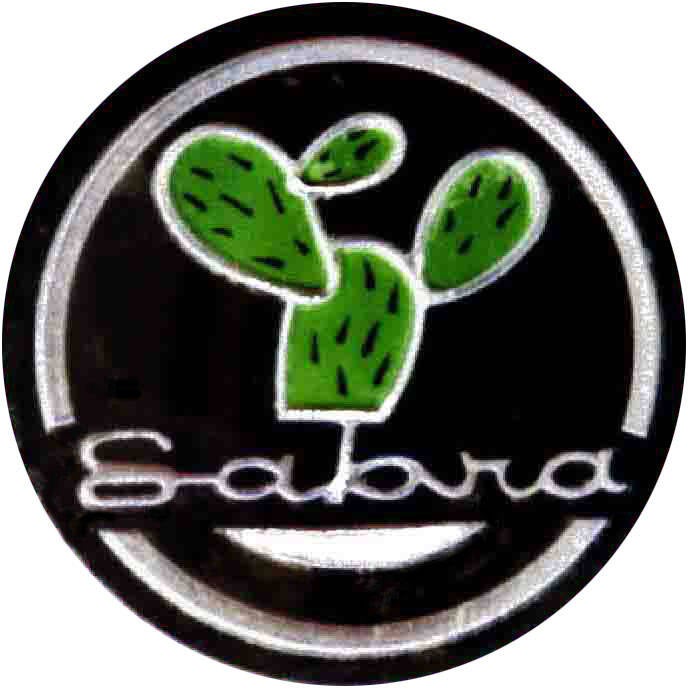
autocars co.




Autocars Co. Ltd. of Haifa, Israel, was Israel's first car manufacturer.
Autocars Ltd, founded in 1957, made fiberglass-shelled cars that were popular in Israel during the 1960s and 1970s. Government agencies were forced to buy them. This released onto the market thousands of low-priced second hand vehicles. Although their style and finish left something to be desired, Autocar's use of Ford and Triumph engines made them reliable cars which kept their value for years. The manufacturing of these cars ceased during the 1980s, and Israel's only remaining car making company today is AIL.
Apart from its own brand, Autocars also assembled other car manufacturers models, such as Reliant Regal, and Triumph 1300 / 1500. These models were built using complete kits received from the brands owners. The Sussita 13/60 was built on the British Triumph Herald's chassis, and used the Herald 13/60 engine and gearbox.

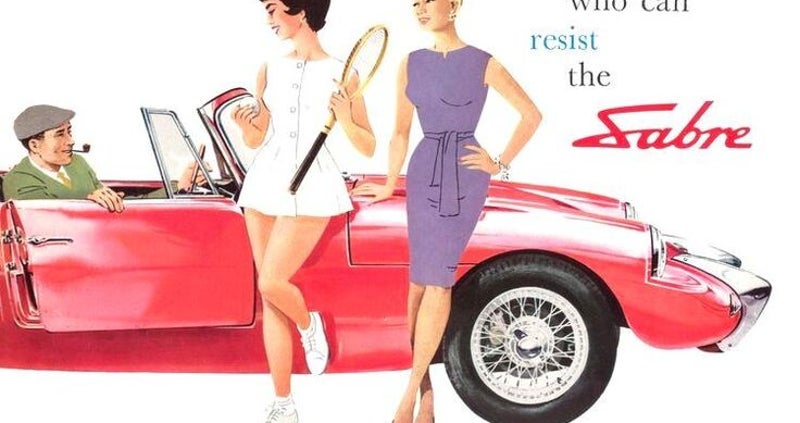

Autocars manufactured its own car models under the Sabra brand. The line included a station wagon, pick-up and the Sabra Sport, a sport car derived from Reliant.

panther rio

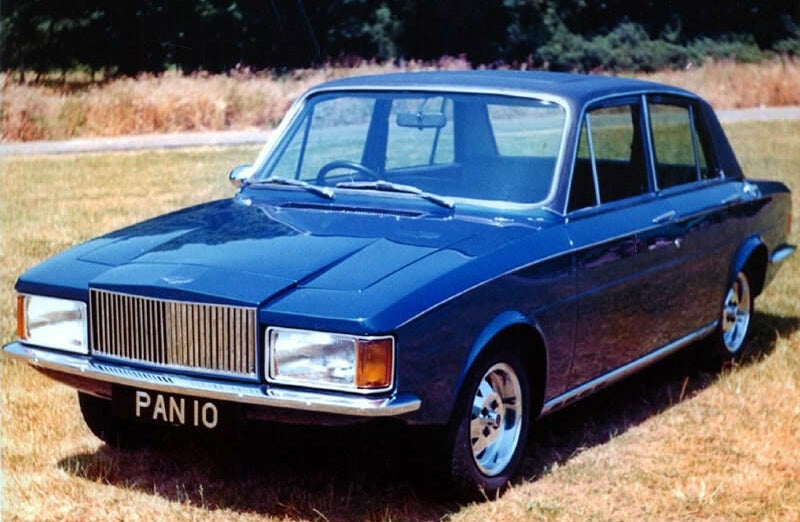


The Panther Rio was a motor car made by British manufacturer Panther Westwinds, using Triumph Dolomite mechanicals. According to the company, it differed from the family saloon-class Dolomite, in being finished to "Rolls-Royce standards". Only 38 were built between 1975 and 1977. A rarer Rio Especial used the high-performance Triumph Dolomite Sprint as its basis. The Triumph Dolomite was selected for improvement, due in part to the vehicle's combination of advanced engines and upright driving position, which offered a blend of modern and traditional luxuries. The Panther Rio was the result, and was launched in September 1975. When released the car had leather and walnut internal fittings and a hand-beaten aluminium skin.
The compact family saloon was offered in two forms: the 1850 cc version, which was the "base" model; and the 2.0 litre 16-valve version (using the engine from the Dolomite Sprint), called the Rio Especial. Problems for the Rio included the fact that the new thicker, fatter seats resulted in a more cramped interior than the Dolomite.
Panther was optimistic over the car's chances and prematurely announced a pre-order of 100 cars from the H.R.Owen luxury line of dealerships. This would have meant a financial boom, clearing the way for the Rio to be offered for sale amongst some of the highest quality vehicles of the time. However, the 100 car deal never materialized and the Rio sold at extremely slow rates, largely in part to customer awareness of the Rio's relatively humble Triumph Dolomite underpinnings.
fury
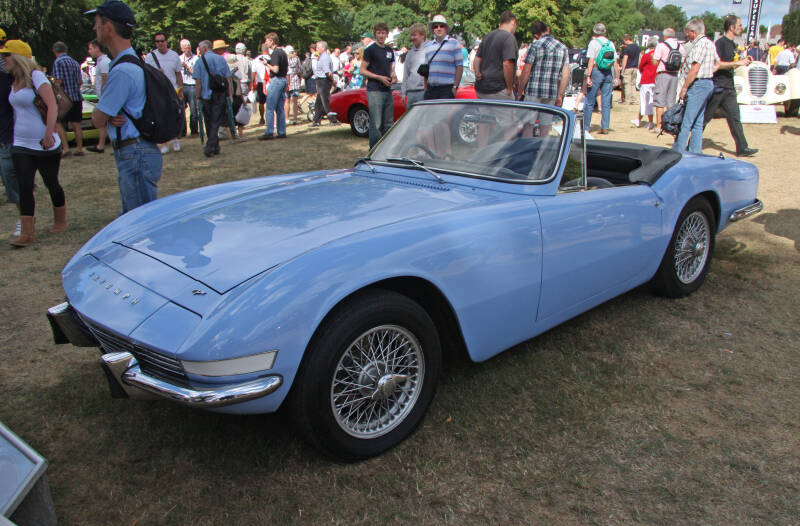
1964
The Triumph Fury was a two-door convertible prototype by the Standard-Triumph Company of Coventry. It was the first monocoque sports car to be made by Triumph. Body design was by the Italian stylist Giovanni Michelotti and the car used components from the 2000 saloon including the 2.0L 6-cylinder engine of the time, although the use of the 2.5L 6-cylinder or the 3.0L Triumph V8 was possibly intended, had the car gone into production. The car lost out to the continuation of the separate-chassis TR series, with the Triumph TR5 being introduced in August 1967. The decision by Triumph to not develop the car was due in part to the reluctance to invest in new production line and tooling facilities required to manufacture the model, in favour of continuing with the simpler manufacturing of the separate body and chassis design of the TR series.
The prototype still exists and is owned by a classic car rental business.
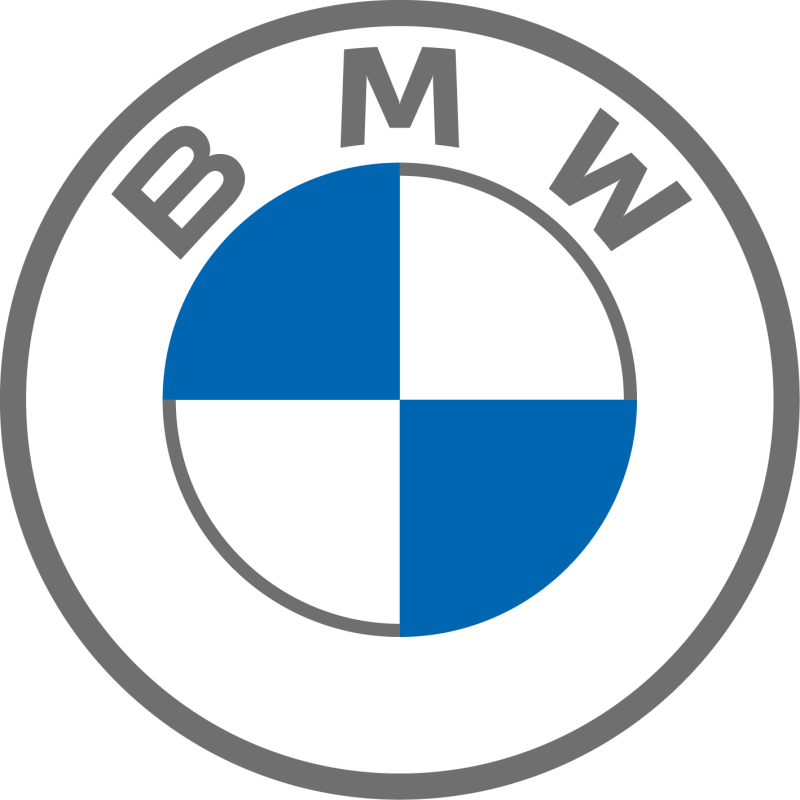
The trademark is owned currently by BMW, which acquired Triumph when it bought the Rover Group in 1994. When it sold Rover, it kept the Triumph marque. The Phoenix Consortium, which bought Rover, tried to buy the Triumph brand, but BMW refused, saying that if Phoenix insisted, it would break the deal. The Standard marque was transferred to British Motor Heritage Limited. The Standard marque is still retained by British Motor Heritage, who also have the licence to use the Triumph marque in relation to the sale of spares and service of the existing 'park' of Triumph cars.
In late 2007, the magazine Auto Express, after continued rumours that Triumph might be revived with BMW ownership, featured a story showing an image of what a new version of the TR4 might look like. BMW did not comment officially on this.
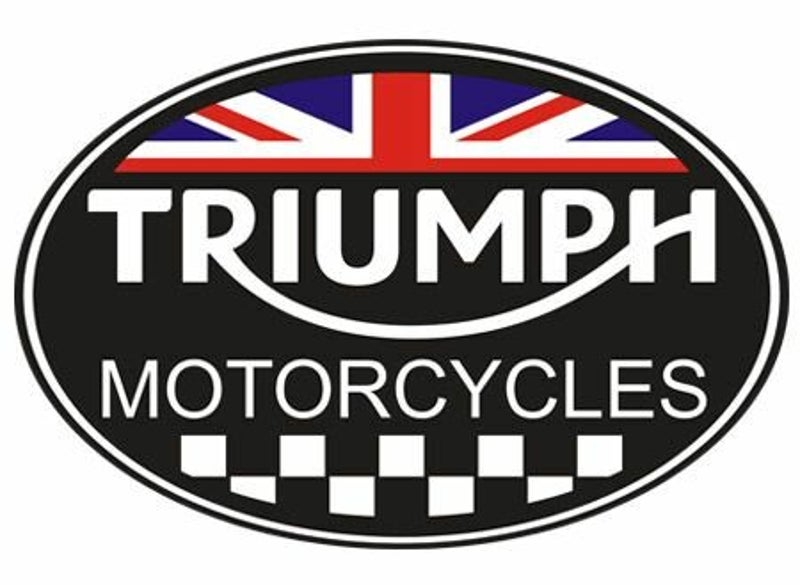
triumph motorcycles ltd

1974-1996



Triumph Motorcycles Ltd is the largest UK-owned motorcycle manufacturer, established in 1983 by John Bloor after the original company Triumph Engineering went into receivership. The new company, initially called Bonneville Coventry Ltd, continued Triumph's lineage of motorcycle production since 1902. They have major manufacturing facilities in Thailand.




A range of new 750 cc and 900 cc triple-cylinder bikes and 1000 cc and 1200 cc four-cylinder bikes were launched at the September 1990 Cologne Motorcycle Show. The motorcycles used famous model names from the glory days of Meriden Triumph and were first made available to the public between March (Trophy 1200 being the first) and September 1991.




From 2019 season onwards for a three-year contract, Triumph are the controlled-engine supplier for the FIM Moto2 World Championship. All Moto2 teams changed from a Honda CBR600 unit to a 765cc triple-cylinder engine supplied by Triumph that was originally developed from the Street Triple RS engine, but with additional race tuning that creates at least 138PS peak power. Engines are prepared by ExternPro, an independent business based in Spain.

2021 triumph rocket 3 r








Create Your Own Website With JouwWeb